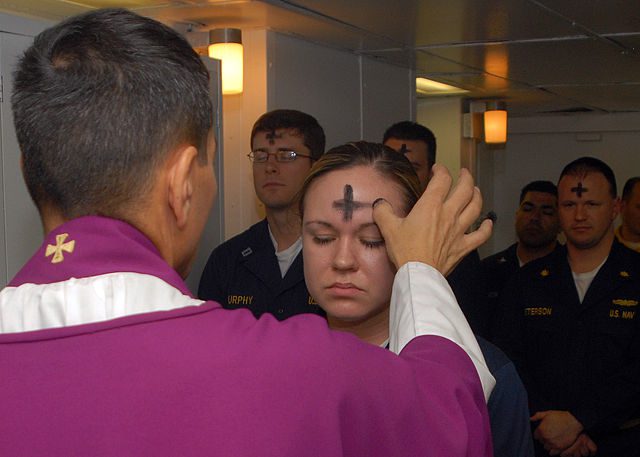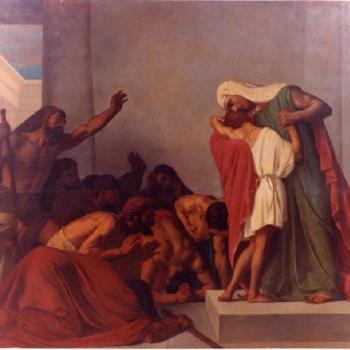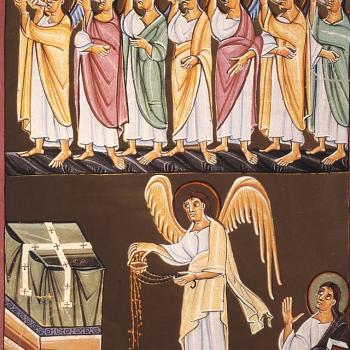
Atlantic Ocean (Feb. 6, 2008) Electronics Technician 3rd Class Leila Tardieu receives the sacramental ashes during an Ash Wednesday celebration aboard the amphibious assault ship USS Wasp (LHD 1). U.S. Navy photo by Mass Communication Specialist 3rd Class Brian May (Released) [public domain / Wikimedia Commons]
*****
At the beginning of Lent, in recent years, the #ashtag controversy (regarding posting pictures of one’s forehead ashes received on Ash Wednesday on social media) has increasingly grown.
My initial take is: why should this practice be controversial, since the ashes are a public and social expression by nature, anyway? A picture simply makes it relatively more public. The thing in and of itself, therefore, seems like a non-starter to me.
What has much more force and reason, I believe, is opposition to doing this with big smiles or otherwise “non-serious” expressions. I think it should be a somber picture and facial expression, in keeping with the occasion.
As usual, then, I take a bit of a “middle position”: not legalistic or “dogmatic” against it, but partially agreeing with the critics about demeanor: that is, it should be a solemn expression and not a gleeful, “look at me!” one. In other words, both sides have their valid points.
In published articles about it, the two “sides” come down in something like the following ways:
Pro: Photographs of forehead ashes make it more community-oriented and are a way to evangelize and spread the faith. We visually bear witness to the world about Christ and His death on the cross on our behalf. If we wear the ashes at the grocery store or bank or at our workplaces, why not also on social media? The U.S. Conference of Catholic Bishops has even urged Catholics to do so. Many priests do this as well. It’s a way, particularly, to reach younger, “digital savvy” / Millennial Catholics who may not go to church any longer. It can be a conversation starter. It’s one of the few days where Catholics proudly identify themselves as such in public.
Con: The Gospel reading for Ash Wednesday (Matthew 6:1-6, 16-18) is about refraining from overtly public “showy” acts of piety. The solemn nature of the day: a reminder that human beings came from dust: to which they shall one day return is diminished or even possibly lost in “smiley, happy” tweets and Facebook displays. The motivations of some may be merely to “show off”. Jesus warned against “the hypocrites” who “love to stand and pray in the synagogues and at the street corners, that they may be seen by men” (Mt 6:5; RSV), and said, “Beware of practicing your piety before men in order to be seen by them” (6:1).
Let’s look at the Gospel passage read on Ash Wednesday, and see if it offers us help in making a decision about whether to do this or not:
Matthew 6:1-6, 16-18 (RSV) “Beware of practicing your piety before men in order to be seen by them; for then you will have no reward from your Father who is in heaven. [2] Thus, when you give alms, sound no trumpet before you, as the hypocrites do in the synagogues and in the streets, that they may be praised by men. Truly, I say to you, they have received their reward. [3] But when you give alms, do not let your left hand know what your right hand is doing, [4] so that your alms may be in secret; and your Father who sees in secret will reward you. [5] And when you pray, you must not be like the hypocrites; for they love to stand and pray in the synagogues and at the street corners, that they may be seen by men. Truly, I say to you, they have received their reward. [6] But when you pray, go into your room and shut the door and pray to your Father who is in secret; and your Father who sees in secret will reward you.” . . . [16] “And when you fast, do not look dismal, like the hypocrites, for they disfigure their faces that their fasting may be seen by men. Truly, I say to you, they have received their reward. [17] But when you fast, anoint your head and wash your face, [18] that your fasting may not be seen by men but by your Father who is in secret; and your Father who sees in secret will reward you.”
At first glance, this would seem to favor the “con” position, but I don’t think so, when examined closely. As so often, Jesus is not talking about a complete, absolute prohibition of a practice, but rather, He is denouncing the hypocrisy of practice without an accompanying proper inner motivation; performing outward acts minus a true inward piety of the heart. This is the prevailing theme in the Sermon on the Mount, from which this passage is drawn.
He’s talking much more about attitude and motivation and possible pride, rather than the acts themselves. After all, Jesus also preached in the same Sermon:
Matthew 5:14-16 “You are the light of the world. A city set on a hill cannot be hid.[15] Nor do men light a lamp and put it under a bushel, but on a stand, and it gives light to all in the house. [16] Let your light so shine before men, that they may see your good works and give glory to your Father who is in heaven.”
I don’t see, then, that the con arguments succeed, if the aim is to condemn such photos altogether. As I contended above, however, I think there is a strong, legitimate argument to be made about demeanor in such displays. While Jesus condemned a fake piety of long faces and ostentatious displays of self-righteousness, on the other hand, the nature of fasting is essentially serious and solemn, and is never, to my knowledge, portrayed as otherwise in Scripture (see, e.g., Job 42:3-6; Dan 9:3; 1 Macc 3:47).
There is a happy medium here. We don’t go out with a “woe is me” miserable attitude on Ash Wednesday, but we also shouldn’t present ourselves giddily smiling as if we were at a circus or child’s birthday party, because that trivializes and misrepresents attempted important outreach.













